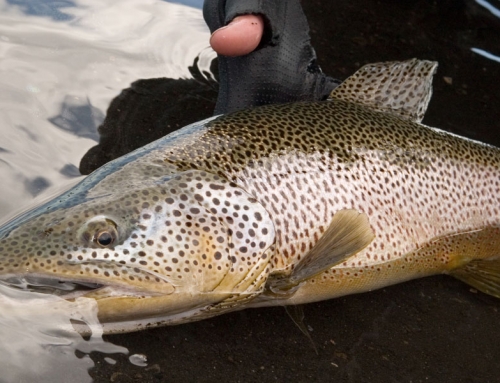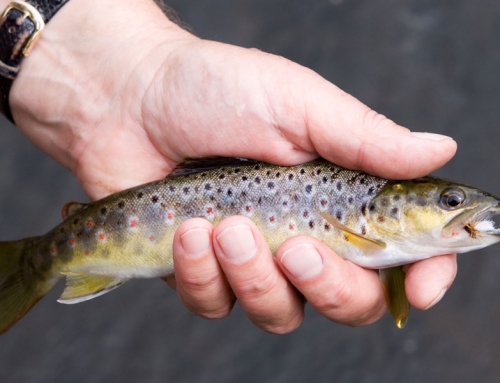Gasping for breath, I’d finally reached the departures entrance at Bristol airport having lugged three huge bags stuffed with my fly-fishing gear from the long stay car park. I was off for a week’s fly-fishing on the Isle of Lewis, part of the Outer Hebrides.
It was the first week of May and with the weather a month or so behind there was still a definite nip in the air, along with plenty of rain. I was however, avoiding the ‘midge season’, which was an obvious advantage. My base was to be a lovely old croft-house; a stones-throw away from the coast and just half a mile from Stornoway Airport. Perfect!
I’d done my homework beforehand, and as ever the internet proving invaluable providing information on many of the more well-known lochs, along with OS grid references. There are however, over one thousand named lochs on Lewis, most of which contain healthy populations of brown trout! Most of the trout fishing on the island is free but it’s worth checking because the island is spit up into estates, with specific lochs requiring permits.
I arrived on a Saturday afternoon and following a quick scout around the island I was desperate to wet a line the next day. I would have to wait until the Monday morning though, as fishing on a Sunday is forbidden in Scotland. In fact, on Lewis it’s frowned upon to even put your washing out on a Sunday! Nevertheless, the free day did allow me to have a recce of the island and get a chance to speak to some locals. As ever, local knowledge is paramount, a time is of the essence for the visiting angler. With such a huge array of lochs at your disposal you don’t want to be wasting any time flogging what’s known locally as ‘a stiff loch’ – in other words, a loch which doesn’t fish particularly well. I was lucky to stumble across local fishing fanatic, Fred Thomas. Fred runs the only stocked rainbow trout fishery on the island and has fished the lochs of Lewis for over twenty years – he was just the man! Before he’d had chance to put the kettle on, my OS map was out on the table with my pen at the ready. During his younger days, loaded up with a huge backpack, Fred would wonder off into the moors for anything up to a week to fish a pod of lochs. He’d been head gillie on many of the famous Estates and his enthusiasm was plain to see – he was in the know and I was all ears! Fred explained that you’ll catch in most of the lochs but the challenge is to find the better fish…
For the first few days I pottered around some of the roadside lochs finding my feet. I caught fish but nothing over the half-pound mark until Fred kindly invited me to join himself and a friend for a day’s fishing. Through the grapevine, he’d heard of an unnamed loch that was producing fish over the pound mark. As ever, the loch was well off the beaten track being over an hour walk across the moorland. We decided to meet at Fred’s fishery at 8am sharp the following morning. I woke to a bright, sunny morning – not ideal for fishing but a blustery wind looked promising. Come 8.30am, Fred, Tom (Fred’s fishing pal) and I had bundled ourselves into a Toyota Hilux for the short mile or so spin to where we parked up at the side of the road. “It’s over that mountain somewhere….” said Fred, slipping on his neoprene chest waders. Now I consider myself to be reasonably fit, but the next hour demonstrated to me that my 9–5 office job was not doing me any favours – walking across that boggy moor was bloody hard work! The landscape is deceiving – everything can look the same at times and when you reach the top of what you think is the final hill, you discover that in fact you’ve got another 20-minutes of walking to go! It’s easy to steer off course, so Fred would periodically check his compass for a bearing. Amazingly, Fred did the walk wearing neoprene’s with a roll-up cigarette constantly in his mouth! I could see why many of the locals these days use quad bikes to reach these places. We traversed down the last ‘wee slope’ and caught our first glimpse of the loch – it looked spectacular, with water glistening bright blue in the sunshine amongst the thick yellow heather. We were in the middle of nowhere and about to fish a place that no angler had been near for a long time…
According to the map there was another loch just to our left but from where we were it was hidden. This was plan B, should the water to turn out be ‘stiff’. We agreed on a temporary basecamp, unloaded our kit, and reached for our fly rods. Fred explains the approach. “We’ll be using traditional wet flies such as the Kate McClaren, Blue Zulu, Bibio and Clan Chief’s on a floating line. Wild browns are opportunists, so fly choice isn’t that critical – generally, something small and dark will work. Remember to keep things simple when fishing exposed, windy places – consider fishing just two flies with quite a short leader. Unless you experience a fly hatch of any significance, you rarely see fish moving but they are there. Most are pulled to the surface following the movement of your wet flies.” I watched as Fred sifted through his fly box and carefully attached three flies to his 6lb maxima cast. Playing safe, being aware of the squally wind, I opted for a 10ft, 6lb fluorocarbon leader and two flies. On the dropper went a size 10 Blue Zulu (my favourite brownie fly) along with a Sunburst Kate McClaren on the point. Tom was first away having decided to try the opposite side of the loch, whereas Fred and I began fishing on the nearest windward shore. Fred went on to explain, “When you approach a loch, never cast a full fly line out. Always work the margins even if most of your fly line lies on the bank. Brown trout love to feed close in and you’ll be surprised what you’ll pick up on your first cast. Always use the ‘cast and walk’ approach and never stay in one place for too long – try and cover as much water as possible throughout the day”.
I distanced myself about 100 yards ahead of Fred and began fishing, working my wet flies around the margins. I tried to maintain a reasonable distance away but I soon realised just how fast he was covering the water – we’d be around this loch in no time! After the next hour or so, we’d fished nearly half the loch only to bring a couple of small fish to hand. Earlier on I noticed that Tom had wondered off in search of the other nearby loch – I assumed that he’d also struggled. The bright sunshine wasn’t helping our cause, but rain was forecast, so I was hopeful things would improve.
At this time, we decided to head back to base camp for a bite to eat. Tom had beaten us to it and was stretched out on the heather soaking up the sunshine. “Any luck boys?”, Tom enquired. “Only a few small ones, that wind is hard work though”, said Fred. With that Tom proudly displayed a bag full of cracking fish, some over the pound mark. “Where the hell did you get them?!”, we replied in stereo. Tom of course had been to explore the other wee loch just over the hill. He had timed it just right and the place was alive – his Clan Chief had done the damage, fished static. He was keen for Fred and me to give the loch a try and pointed towards the best approach to the water. He’d decided to give our loch another try.
Following a ten-minute walk, Fred and I had reached the new loch and were looking out for landmarks Tom had mentioned. It was a completely different place, much more sheltered from the surrounding high banks. We could even see fish rising – always a welcome sight! What followed was nearly an hour’s frantic fishing – it was virtually a fish a cast for us until the heavens opened with driving, horizontal rain. Visibility soon became very poor, and it was time to re-group and begin our trek home. I must admit, I did feel uncomfortable knowing just how far away our vehicle was, but I was in safe hands with the locals. When those moors get wet, it makes for much more difficult walking. If a patch looks particularly wet, treat it with respect; otherwise, you could get into all sorts of trouble. After nearly 45mins, we could see the Hilux in the distance. I was soaked through and looking forward to a sit down. Another challenging but rewards days fishing and Fred and Tom had discovered another wee loch that’s worth the walk across the moorland.
An overview of my Lewis experience…
The most important piece of kit is a good pair of breathable stocking foot waders. When you are traipsing for miles across boggy moorland, they are essential. You don’t wade much but chest waders keep you dry with changeable weather conditions. They also keep you clean because you will come across some boggy, muddy moorland. Another handy piece of kit is a waist bag or better still a chest pack, providing easy access to all your essential kit. There isn’t a great amount of tackle available on the island and what is there is expensive – so be prepared. I actually took a float tube with me too, but I never used it and the extra baggage cost at the airport proved unnecessary. Bank fishing is the safest and most productive approach. Lewis is an exposed island and it’s always windy. Even with the dreaded northerly and easterly winds, certain lochs will be more ‘fishable’ than others because they face in different directions, so study the map and choose your lochs appropriately.
Don’t expect to catch monsters, most fish are under a pound, but most competent anglers should catch between 10–20 fish during a day on the fly, if you cover as much water as possible. Some locals prefer to fish the spinner or worm as these methods tend to take larger fish. Locals suggest that with lower PH levels, many lochs are producing smaller fish due to the lack of nutrients reaching the waters with less septic tanks and other effluents. Of course, it’s not just wild brown trout fishing that Lewis has to offer. The island has some of the best salmon and sea trout fishing in Scotland. During just ten outing last year (2005), Fred caught over ninety salmon and sea trout on the fly! On a sad note, I hear some of the lochs on the island are being wiped out with the introduction of wind farms.
By the end of my weeks visit, I’d fished seven lochs. It was certainly one big adventure from begging to end and I know where my camper van will be heading when I retire… If you’re looking for wild un-spoilt, brown trout fishing then in my opinion there is no better place than Lewis. It really is a fly fisherman’s paradise.




Interesting article, well written and informative. More like this please! Fly Fishing novice willing to learn.
Thanks for the blog.
Hi. I’m an outdoor writer from Canada. Just discovered your page. I’m doing an article on this region for Ontario OUT OF DOORS magazine.
I’m flying into Stornoway on Monday. Can you email me?